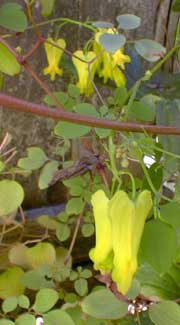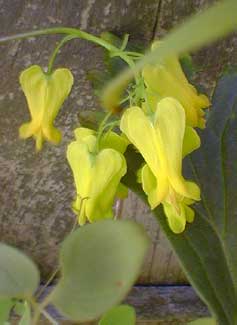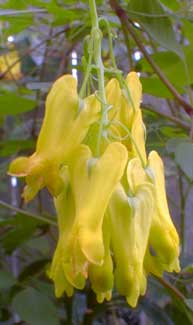
Climbing Yellow Bleeding Heart;
aka, Golden Tears Vines
"A fairy seed I planted, so dry & white & old,
there sprang a vine enchanted, with magic flowers of gold."
-Marjorie Barrows,
flourished 1930s thru 1950s
flourished 1930s thru 1950s
Yellow bleeding heart vine (Dicentra scandens) is, alas, one of the "tender perennials" that may not return a second year. It bloomed so well in our garden during the first year we had it, I knew I would hugely miss it if it were gone after winter.
Reports on the ease of keeping it going many years as a perennial do vary. Some people complain that delicate spring sprouts are killed at first sign of even a mild late frost. But others say it thrives without much attention at all. One correspondent emailed me asking why theres had not bloomed even once, though the vines were healthy climbers. I could only guess that too much or too little sun was the problem, but mostly I've no idea why it seems an easy little plant for some gardeners, troublesome for others.
It likes maritime climates, consistenty moist soil, & either morning sun or dappled afternoon sun, but not both. I felt like we'd given it its ideal conditions, but even so braced myself for the possibility that it'll be a defacto annual.
I was impatiently watching for it to come back its second spring, but wasn't sure if the early spring foliage I spotted was a regular bleedingheart such as seed themselves about the garden at will. But come May the tiny clump of ferny leaves stretched upward, climbing to the top of a fairly tall Arends' Monkshood. Wee hoo! Even after a particularly hard winter, it had come through!
 Yet that second year it seemed more frail or less floriferous than the first year, & I decided it was in too deep of shade, so I moved it in Autumn, to a morning-sun location, moving the monkshood at the same time in one huge clump of soil molesting their roots minimally. The third year, its first in the new location, it sprang up very excitedly, climbing all through the hugely clumping monkshood & through the nearby Elf's home spirea. It began blooming in July, hundreds & hundreds of long yellow hearts.
Yet that second year it seemed more frail or less floriferous than the first year, & I decided it was in too deep of shade, so I moved it in Autumn, to a morning-sun location, moving the monkshood at the same time in one huge clump of soil molesting their roots minimally. The third year, its first in the new location, it sprang up very excitedly, climbing all through the hugely clumping monkshood & through the nearby Elf's home spirea. It began blooming in July, hundreds & hundreds of long yellow hearts.In the meantime I had planted a second one in another location in case the first one failed to take, so I ended up with two very successful plantings. The second one was planted in a bright shade garden where it could climb through some dwarf azaleas & a large rhododendron. The shrubs' blooms are long gone by the time the yellow hearts are twining about the shrubs' foliage. Leaves & blooms alike are too small to be even a small threat to the shrubs, so climbing yellow bleeding hearts are ideal for this purpose.
It wants partial or bright shade here in zone 8, though if too shady it won't bloom, or it won't bloom as intensely. Further north it would want an increasingly sunny position, whereas further south it would require a great deal of protection from heat. Although some growers recommend it down to zone 6, it would much more certainly have to be grown as an annual, as it just does not want a cold winter.
 When it dies back in winter, mulching the tubrous roots should increase the odds of perennial success, though I've made no particular effort to do this (I do winter-mulch much of the garden with whatever leaves fall nearby). For spring through fall, rich moist humusy soil keeps it extremely happy.
When it dies back in winter, mulching the tubrous roots should increase the odds of perennial success, though I've made no particular effort to do this (I do winter-mulch much of the garden with whatever leaves fall nearby). For spring through fall, rich moist humusy soil keeps it extremely happy.It has the brightest yellow bleedingheart flowers, & ferny corydalis-like leaves. But what it has that is so unusual for dicentra or corydalis is tendrils by which it climbs walls, fences, or trunks of trees. It might only climb about three or four feet, but eight feet isn't at all unlikely, & twelve feet is not unheard of if it particularly likes its location & conditions. Our first planting was only reaching about six feet in its third year.
The rich yellow blooms on this Himalayan native of Nepal & Tibet occur in clusters very numerously, so the impact of the little vine can be startling. It continues blooming all summer long & until first frost. Flowers turn into reddish bean-shaped pods that are themselves very interesting.
It is somewhat rare in the nursery trade for several reasons, but the main one is that it does not give a long ideal presentation in a nursery pot. It grows too rapidly & its delicate stems if batted around are quickly damaged causing lower leaves to die. None of these faulty features present themselves in the right garden location, but a nursery needs them to be nice-looking in pots for longer than a few days. Potted bleedingheart vines too swiftly become scruffy & thus difficult to sell.
The first one we bought was in fact extremely scruffy & worn out, but I recognized what it was, & had wanted just this perennial for a long while. So I took the chance that it would perk up in the garden, which it did in a matter of a couple of days.
So if you do see one that seems quite alive, but looks rangy with a lot of damaged bits from overgrowing its pot, get it anyway. If you get it in the ground at any time in spring, it'll have plenty of time to put itself in order & bloom stunningly all summer long.